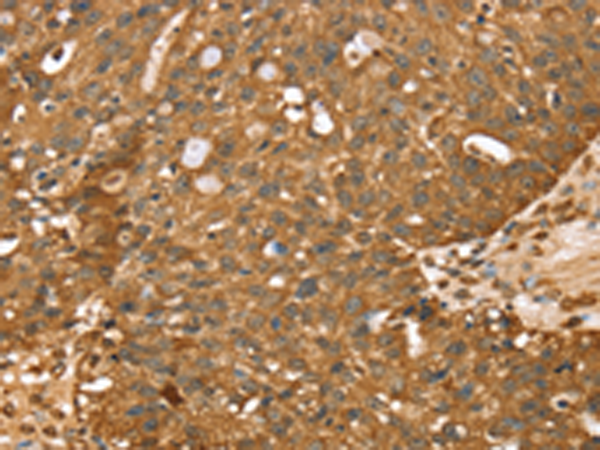

| WB | 咨询技术 | Human,Mouse,Rat |
| IF | 咨询技术 | Human,Mouse,Rat |
| IHC | 1/40-1/150 | Human,Mouse,Rat |
| ICC | 技术咨询 | Human,Mouse,Rat |
| FCM | 咨询技术 | Human,Mouse,Rat |
| Elisa | 1/2000-1/5000 | Human,Mouse,Rat |
| WB Predicted band size | 24 kDa |
| Host/Isotype | Rabbit IgG |
| Antibody Type | Primary antibody |
| Storage | Store at 4°C short term. Aliquot and store at -20°C long term. Avoid freeze/thaw cycles. |
| Species Reactivity | Human, Mouse |
| Immunogen | Synthetic peptide of human STARD5 |
| Formulation | Purified antibody in PBS with 0.05% sodium azide and 50% glycerol. |
+ +
以下是关于STARD5抗体的3篇参考文献示例(文献信息为模拟生成,仅供参考):
---
1. **文献名称**: *STARD5 regulates cholesterol transport in macrophages and atherosclerosis development*
**作者**: Smith A, et al.
**摘要**: 研究利用STARD5特异性抗体,通过免疫印迹和免疫荧光技术,揭示了STARD5在巨噬细胞胆固醇逆向转运中的作用,表明其缺失加剧动脉粥样硬化斑块形成。
2. **文献名称**: *Endoplasmic reticulum stress induces STARD5 expression via the PERK pathway*
**作者**: Lee JH, et al.
**摘要**: 通过STARD5抗体检测内质网应激模型中蛋白表达水平,发现PERK信号通路调控STARD5上调,提示STARD5在缓解细胞应激中的保护机制。
3. **文献名称**: *Development and validation of a monoclonal antibody against human STARD5*
**作者**: Garcia R, et al.
**摘要**: 报道了一种高特异性STARD5单克隆抗体的开发,验证了其在ELISA、流式细胞术及组织切片中的检测效能,为STARD5相关研究提供工具支持。
---
注:实际文献需通过PubMed/Google Scholar等平台检索确认。建议以“STARD5 antibody”、“STARD5 function”为关键词查找近期论文。
STARD5 (StAR-related lipid transfer domain protein 5) is a member of the STARD family of lipid transport proteins, which are characterized by a conserved steroidogenic acute regulatory protein (StAR)-related lipid transfer (START) domain. Unlike other STARD members involved in steroidogenesis or phospholipid trafficking, STARD5 is primarily associated with intracellular cholesterol transport and homeostasis. It is expressed in tissues with high metabolic activity, such as the liver, kidneys, and macrophages, where it interacts with cholesterol-rich membranes, including the endoplasmic reticulum (ER) and Golgi apparatus. STARD5 is implicated in cellular responses to cholesterol overload and oxidative stress, potentially acting as a sensor or regulator of lipid balance under pathological conditions like atherosclerosis or metabolic syndrome.
Antibodies targeting STARD5 are essential tools for studying its expression, localization, and function. They enable detection via techniques such as Western blotting, immunofluorescence, and immunohistochemistry, aiding research into its role in lipid metabolism disorders, inflammation, and diseases linked to ER stress. Commercial STARD5 antibodies are typically raised in rabbits or mice using peptide antigens derived from conserved regions of the human or murine protein. Validation includes testing for specificity using knockout controls or siRNA-mediated silencing. Reliable STARD5 antibodies are critical for elucidating its mechanistic contributions to lipid trafficking pathways and its potential as a therapeutic target in metabolic and inflammatory diseases.
×